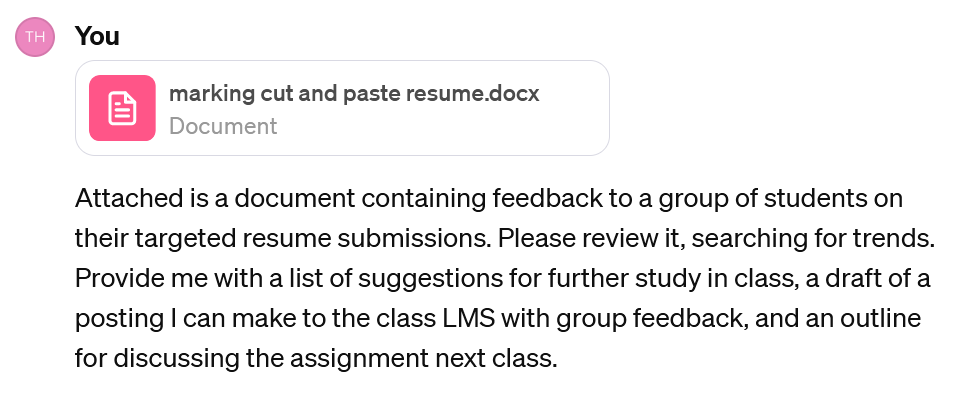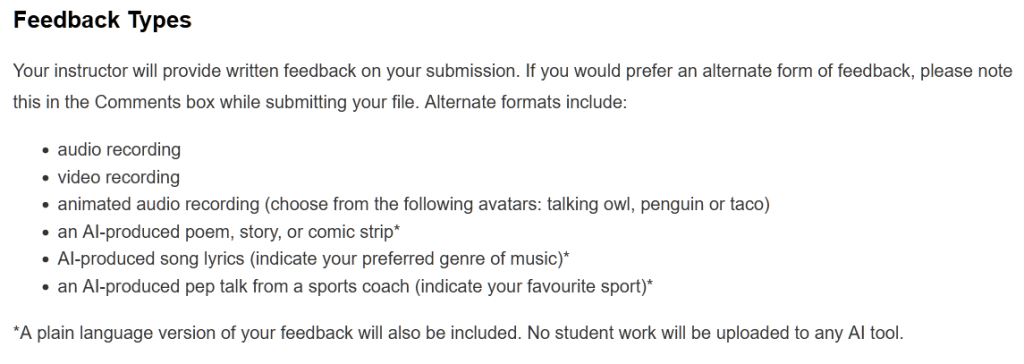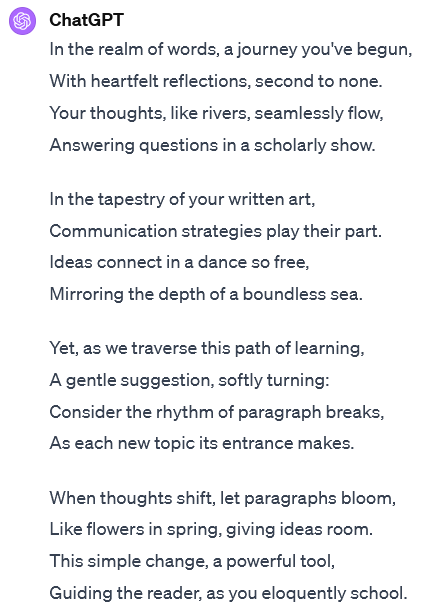11
How can AI tools help with feedback and grading?
This chapter explores:
- using AI tools as a source of formative feedback;
- how AI tools can assist with summative feedback;
- fun ways to use AI to make feedback more engaging.
Formative Assessment
As explored in the Using AI to Enhance Learning chapter, AI tools can be used by students as a means to get formative feedback on draft work—for example, by uploading a draft to an AI tool and asking for a targeted list of suggestions for improvement, or by engaging in a quiz activity with an AI tool. When institutional and departmental policies allow, instructional staff may wish to try in-class or homework activities in which students engage with AI tools in order to get formative feedback. Prior to such activities, students need to be informed about potential for errors, privacy concerns, and institutional policies surrounding the sharing of course materials.
Some institutions, like McMaster University, are allowing and encouraging instructors to also use AI tools to produce formative feedback on student work, providing that students are informed in the course outline and in class, and data collection is turned off.[1] Instructional staff who wish to use AI tools to produce formative feedback for their courses should ensure that institutional policies around use of AI tools and sharing of student information are followed.
Some potential applications for AI-based formative feedback are:
- submitting written work and a rubric or learning outcomes and asking for suggestions for improvement;
- analyzing a transcript of an online meeting and asking AI to generate individualized engagement feedback;[2]
- having an AI tool analyze student-produced code and offer suggestions.
Summative Assessment
Instructional staff may be hesitant or unable to use AI tools as part of summative assessment grading and feedback. This may be due to a a lack of institutional approval, worries about accuracy and bias in AI output, reputation and credibility concerns, and privacy issues. One 2024 survey of academics indicated enthusiasm over using AI tools to grade work that has simple correct and incorrect answers, but skepticism about the ability of AI tools to grade work involving creativity and critical thinking.[3] Even if institutional policy allowed AI-based grading, instructors would need to carefully consider whether or not to rely on AI tools for this important part of their work, considering the potential impacts that it could have on privacy, accuracy, fairness, and their understanding of students’ achievement levels.
AI tools can be employed in drafting summative assessment feedback. One way to improve efficiency is for the grader to take notes in their preferred style while reviewing student work, then have an AI tool turn it into a cohesive paragraph or set of bullet points.[4] Voice-to-text tools like AudioPen can also be used to save time while drafting feedback.
AI tools can also review a document containing every student’s individual feedback on an assignment and search it for trends, suggesting areas for further skill development or drafting an email to the class. Click the image below for an example of how ChatGPT responded to a request for feedback analysis.

Alternative Forms of Feedback
Instructors may find that some students check their grades but don’t fully evaluate written feedback. AI tools can be used to increase student engagement with written feedback by providing a creative alternative that supplements written feedback. University of Leeds Professor Chrissi Nerantzi and colleagues suggest using AI tools to convert instructor feedback to poetry in order to increase student interest,[5]—other options could include song lyrics, a story, or a monologue in a particular style. Since many students prefer feedback in plain language, this should be offered only as an optional supplement to plain language feedback, not a substitute. See the following image for an example of how to offer feedback in alternate formats as an option.

The next image shows the beginning of a feedback poem generated by ChatGPT. Click the image to see the full poem, and the original feedback, plus ChatGPT’s attempt at turning it into a story, country music song lyrics, and a football pep talk (login required).

Key Takeaways
- Students can use AI tools as a way to get more formative feedback.
- AI tools can provide some assistance with summative feedback.
- AI tools can translate feedback into a variety of engaging formats, potentially increasing student interest in reviewing feedback.
Exercises
- Examine your institution’s policies around sharing student-produced content with an AI tool in order to determine limitations for AI tools in feedback and grading.
- Experiment with ways that AI tools can assist in writing feedback. For example, submit a set of notes to an AI tool and ask it to convert it to a paragraph, or provide verbal feedback using a voice-to-text AI tool. Consider whether the output is readily usable as assessment feedback, or whether revision is required.
- Paul R. MacPherson Institute for Leadership, Innovation and Excellence in Teaching, "Generative Artificial Intelligence in Teaching and Learning at McMaster University," McMaster University, last modified 2023, https://ecampusontario.pressbooks.pub/mcmasterteachgenerativeai/. ↵
- John Spencer, "Sal Khan on A.I. and Personalized Learning," John Spencer, last modified August 8, 2023, https://spencerauthor.com/sal-khan/. ↵
- Paul Breen, "Academics Wouldn’t Drink to the Handover of Marking to AI," Times Higher Education, last modified January 27, 2024, https://www.timeshighereducation.com/blog/academics-wouldnt-drink-handover-marking-ai. ↵
- Danny Liu, "Prompt Engineering for Educators—Making Generative AI Work for You," University of Sydney, last modified April 27 2023, https://educational-innovation.sydney.edu.au/teaching@sydney/prompt-engineering-for-educators-making-generative-ai-work-for-you/. ↵
- Chrissi Nerantzi, Sandra Abegglen, Marianna Karatsiori, and Antonio Martínez-Arboleda, "101 Creative Ideas to Use AI in Education, A Crowdsourced Collection," Zenodo, last modified 2023, https://doi.org/10.5281/zenodo.8072950. ↵
A feature that users can toggle on some AI tools. When data collection is turned off, the tool will not use inputs to improve its models. To toggle this setting in ChatGPT, click on the user name in the bottom right corner, then Settings, Data Controls, Chat History & Training.

